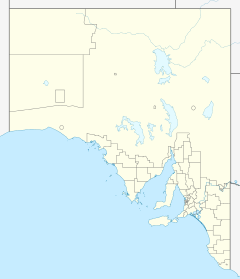Mulka Station facts for kids
Mulka Station is a very large cattle farm. It is located in the far north of South Australia. This land is a 'pastoral lease,' which means it is rented from the government for farming. The area around Mulka Station was officially named "Mulka" by the South Australian government in 2013.
Contents
Where is Mulka Station?
Mulka Station is about 154 kilometers (96 miles) north of Marree. It is also about 216 kilometers (134 miles) west of Innamincka. The main way to reach the property is by driving on the unpaved Birdsville Track.
Mulka's Climate
Mulka Station has a very hot and dry climate. This type of climate is called an arid climate. It is the driest permanently settled farm in Australia. It gets only about 10 centimeters (4 inches) of rain each year.
In 1929, a severe drought hit the area. People worried that everyone, including local Indigenous Australians, would have to leave. In 2005, the drought was so bad that all the cattle had to be moved off the property. By 2010, good rains had arrived further north. This caused Cooper Creek to flow all the way to Lake Eyre.
History of Mulka Station
Denis and Gabrielle Overton bought Mulka Station in 1983. The property covers a huge area of 5,600 square kilometers (2,162 square miles). Both Lake Hope and Red Lake are located within the station's boundaries.
Mulka Station was first set up before 1889. Back then, it was a sheep farm. In 1889, the owner, James White, sold Mulka. He also sold Canatalkina Run, which together had 6,000 sheep.
The Mulka Store
George "Poddy" Aiston took over Mulka Station around 1923. He had been a policeman before this. By 1925, he built the Mulka Store near the Mulka Bore. This store was on the Birdsville Track. It was the only store in a huge area of about 70,000 square kilometers (27,000 square miles). The store sold almost everything you could imagine. Today, the ruins of the Mulka Store Ruins are a protected heritage site in South Australia.
From 1933 to 1934, the property was hit by another drought. George Aiston was unsure if his 1,000 cattle were still alive. Later in 1934, the area had dust storms, followed by heavy rain. This caused the creeks to flood. George Aiston passed away in 1943. However, his wife Mabel continued to run the store until 1951.
Airmail and Fishing
In 1949, airmail delivery started for remote farms in the outback. Mulka Station was one of the many remote properties that received mail by plane.
After three big floods filled Lake Hope in 1989, 1990, and 1991, the owners of Mulka Station, Denis and Gabrielle Overton, received a special fishing license in 1991. In 2000, Denis passed the fishing license to his brother, Gary Overton.
Gary Overton used his license to start catching fish in Lake Hope. He caught Lake Eyre Golden Perch, Welch's Grunter, and the Barcoo Grunter. The license allows him to remove up to 350 tonnes (386 tons) of these fish. But he can only do this after the lakes have separated from the Cooper Creek after a flood.
In 2012, floodwaters returned to the area. This allowed Gary Overton to catch up to 5 tonnes (5.5 tons) of fish each week. These fish were trucked to Adelaide. Ice was brought back on the return trip to keep the fish fresh. At that time, the station also had about 3,000 cattle.


